
To understand why President Trump’s withdrawal from Syria has unleashed such violence, it helps to see this moment as the culmination of a problem that has been building since the conflict began. In the war’s first days, northern Syria’s large Kurdish population effectively seceded and, later, came to control the area. The war’s many actors, Kurds included, knew this was, in the long term, not sustainable. The Kurds were too weak to hold out forever. But they were too strong, too fearful of outside dominance and, over the course of the war, had built too many institutions of self-rule to be simply folded back into the Syrian state. At the same time, the outside world saw Kurdish autonomy as essential to running out the Islamic State, but knew it was, long-term, a barrier to ending the war. Syria’s government would never accept losing the north’s oil and agricultural wealth. Turkey’s government, just across the border, saw permanent Kurdish autonomy as an unacceptable threat. This became the northern Syria problem: How to reconcile these contradictions and create a sustainable, broadly acceptable equilibrium in northern Syria. Only then could the world hope to make the Islamic State’s defeat permanent and to end…